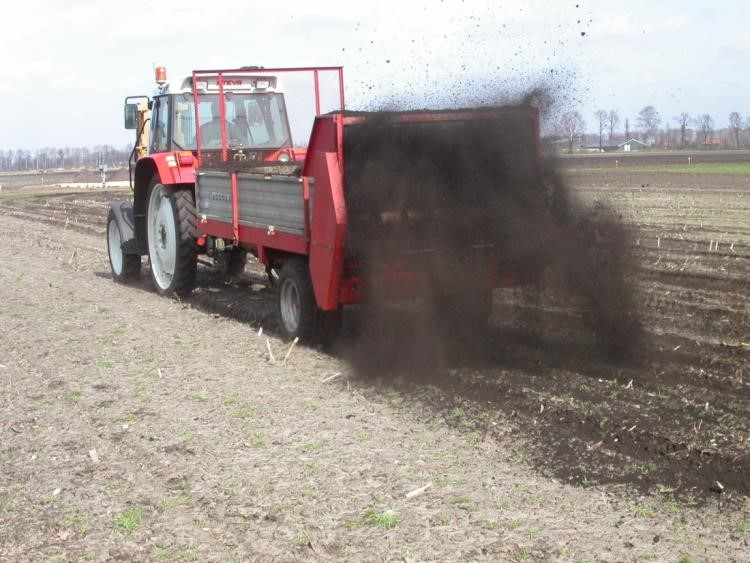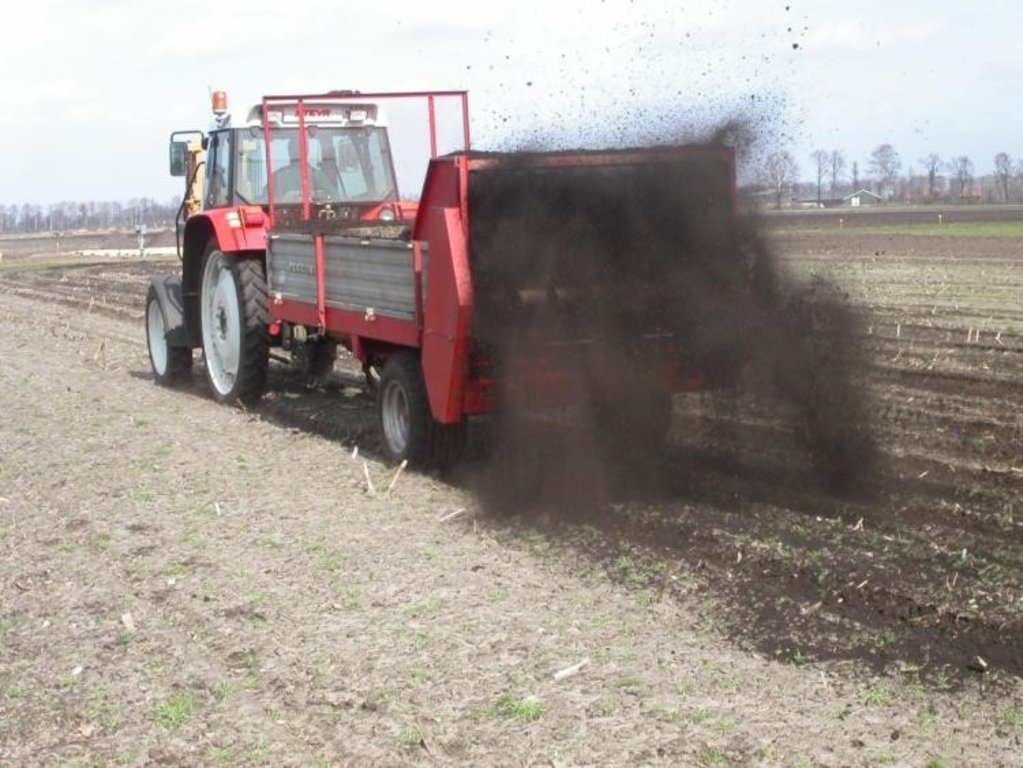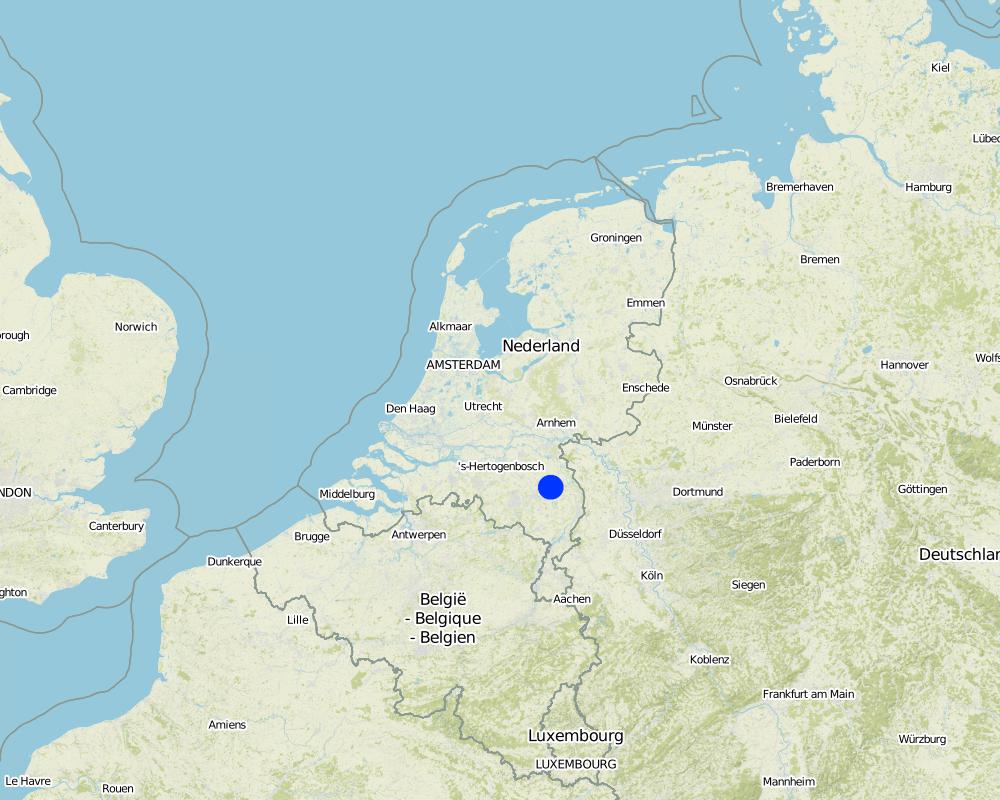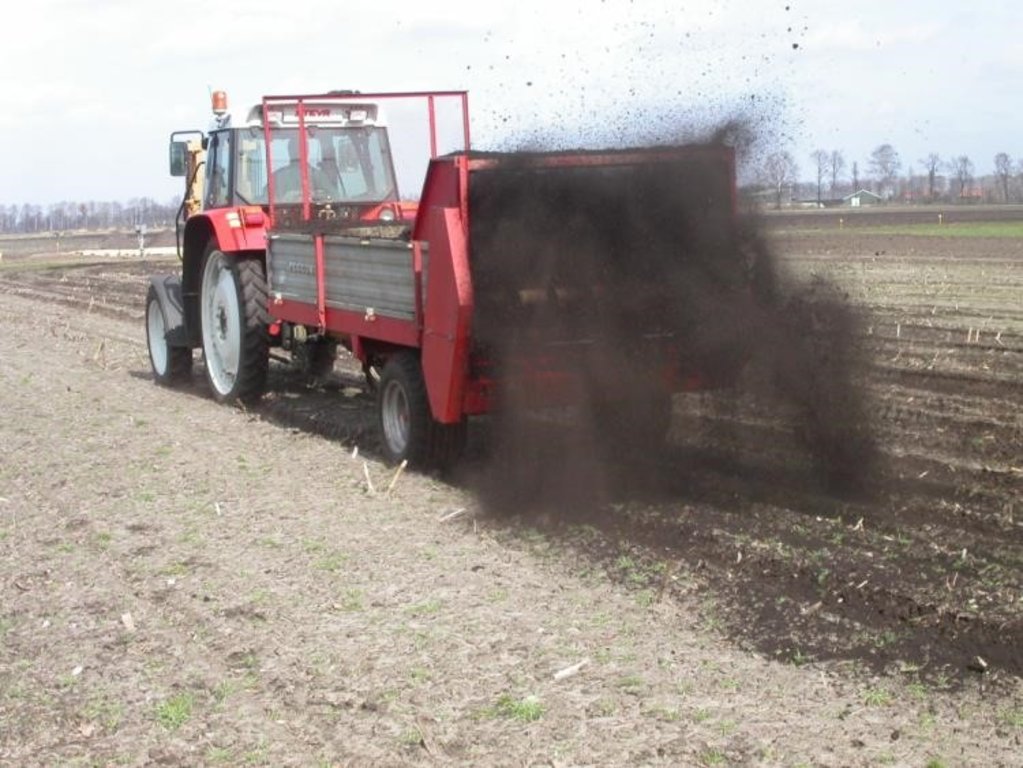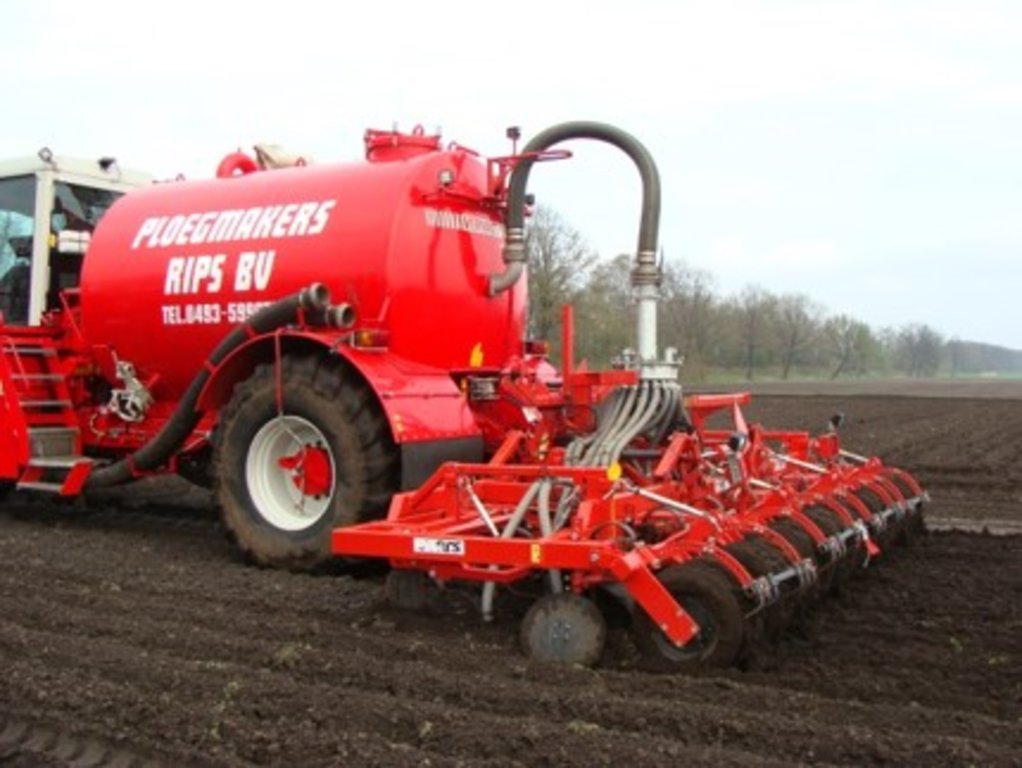Increased organic matter input by using organic fertilizers (slurry and manure) instead of mineral fertilizers [Netherlands]
- Creation:
- Update:
- Compiler: wijnand sukkel
- Editor: Marie Wesselink
- Reviewers: Ursula Gaemperli, Gudrun Schwilch, Alexandra Gavilano
Verhoogde organische stof aanvoer door gebruik van organische bemesting in plaats van minerale bemesting
technologies_2965 - Netherlands
View sections
Expand all Collapse all1. General information
1.2 Contact details of resource persons and institutions involved in the assessment and documentation of the Technology
Name of project which facilitated the documentation/ evaluation of the Technology (if relevant)
Interactive Soil Quality assessment in Europe and China for Agricultural productivity and Environmental Resilience (EU-iSQAPER)Name of the institution(s) which facilitated the documentation/ evaluation of the Technology (if relevant)
Stichting Dienst Landbouwkundig Onderzoek, Wageningen University & Research Centre (DLO) - Netherlands1.3 Conditions regarding the use of data documented through WOCAT
The compiler and key resource person(s) accept the conditions regarding the use of data documented through WOCAT:
Yes
1.4 Declaration on sustainability of the described Technology
Is the Technology described here problematic with regard to land degradation, so that it cannot be declared a sustainable land management technology?
No
2. Description of the SLM Technology
2.1 Short description of the Technology
Definition of the Technology:
Mineral ferilizers are (partly) replaced by organic fertilizers in order to have a higher organic matter input
2.2 Detailed description of the Technology
Description:
The technology is applied in arable/vegetable production systems in de Peel. De Peel is a sandy soil rural region in the southeast of the Netherlands. The technology is not limited by soil type or crop production system. An important requisite is the availability of manure.
The technology is applied on conventional farms. Mineral fertilizers are (partly) replaced by organic fertilizers. The yearly crop fertilization is mainly based on slurry which is in abundance available in the region. The amount of organic fertilizers is restricted by national and regional legislation related to the total input of Nitrogen and Phosphorus. Occasionally additional solid manure and/or compost is put in (autumn). Extra organic matter input by manure is sometimes combined with emphasis on the use of cover crops which gives an additional input of organic matter as well.
Main purposes of the technology are to improve soil quality in general, reduce wind erosion, reduce nitrate leaching, increase soil biodiversity and make the soil more resilient to stress factors like drought or excessive rainfall.
Major activities are reduction of mineral fertilisers and the increase of organic fertilizers. This is accompanied by the additional use of cover crops whenever possible.
The impacts are so far an increase of soil organic matter, an increase of soil biodiversity, higher yields and a higher soil resilience.
Landusers like the technology because of the better soil quality, increase of yields, lower input costs (farmers are paid to use manure, since there is an excess in the region ). farmers dislike the technology because of the risks of compaction because of the heavy loads of slurry. Another negative effect is the less predictable nutriënt availability in the soil of organic fertilisers. Also the costs and of additional sowing of cover crops is considered a negative aspect. Having the correct machinery is not an issue, since there are a lot of cooperations with contractors who can do the application for you.
2.3 Photos of the Technology
2.5 Country/ region/ locations where the Technology has been applied and which are covered by this assessment
Country:
Netherlands
Region/ State/ Province:
De Peel
Further specification of location:
Near the village Vredepeel
Specify the spread of the Technology:
- evenly spread over an area
Comments:
I think the area size depends on how big you estimate the study site area, but most of the farmers use (at least partly) organic manure. This may be up around 80% of the farmers.
Map
×2.6 Date of implementation
Indicate year of implementation:
1998
2.7 Introduction of the Technology
Specify how the Technology was introduced:
- during experiments/ research
Comments (type of project, etc.):
Research has shown that organic matter input is of vital importance if you want to maintain your soil quality. Farmers know this, all farmers in the region use at least partly organic manure.
3. Classification of the SLM Technology
3.1 Main purpose(s) of the Technology
- improve production
- reduce, prevent, restore land degradation
- preserve/ improve biodiversity
- adapt to climate change/ extremes and its impacts
- create beneficial economic impact
3.2 Current land use type(s) where the Technology is applied

Cropland
- Annual cropping
Annual cropping - Specify crops:
- cereals - barley
- cereals - maize
- legumes and pulses - peas
- root/tuber crops - potatoes
- root/tuber crops - sugar beet
- vegetables - root vegetables (carrots, onions, beet, other)
Number of growing seasons per year:
- 1
Comments:
Main crops (cash and food crops): sugarbeet, processing peas, leek, carrots, spring barley, silage maize, potatoes
3.4 Water supply
Water supply for the land on which the Technology is applied:
- mixed rainfed-irrigated
3.5 SLM group to which the Technology belongs
- integrated soil fertility management
3.6 SLM measures comprising the Technology

agronomic measures
- A1: Vegetation/ soil cover
- A2: Organic matter/ soil fertility
3.7 Main types of land degradation addressed by the Technology

soil erosion by wind
- Et: loss of topsoil

chemical soil deterioration
- Cn: fertility decline and reduced organic matter content (not caused by erosion)

physical soil deterioration
- Pc: compaction

biological degradation
- Bl: loss of soil life

water degradation
- Hq: decline of groundwater quality
3.8 Prevention, reduction, or restoration of land degradation
Specify the goal of the Technology with regard to land degradation:
- prevent land degradation
4. Technical specifications, implementation activities, inputs, and costs
4.1 Technical drawing of the Technology
Technical specifications (related to technical drawing):
Before planting/sowing organic manure is added to the soil, either by spreading it on top of the soil (photo 1) or injecting it in the soil (photo 2)
4.2 General information regarding the calculation of inputs and costs
Specify how costs and inputs were calculated:
- per Technology area
Indicate size and area unit:
50 ha
other/ national currency (specify):
Euro
If relevant, indicate exchange rate from USD to local currency (e.g. 1 USD = 79.9 Brazilian Real): 1 USD =:
0.87
Indicate average wage cost of hired labour per day:
160
4.4 Costs and inputs needed for establishment
Comments:
There are no costs for establishment. Possibly in some case equipment to spread slurry, however this is mostly done by contract work.
4.5 Maintenance/ recurrent activities
| Activity | Timing/ frequency | |
|---|---|---|
| 1. | fertilisation with slurry | once a year in early spring |
| 2. | sowing of cover crops | late summer/ early autumn |
| 3. | incorporating cover crops | late winter/early spring |
4.6 Costs and inputs needed for maintenance/ recurrent activities (per year)
| Specify input | Unit | Quantity | Costs per Unit | Total costs per input | % of costs borne by land users | |
|---|---|---|---|---|---|---|
| Plant material | seed costs and sowing cover crops | ha | 50.0 | 100.0 | 5000.0 | 100.0 |
| Fertilizers and biocides | compost application | m3 | 250.0 | 15.0 | 3750.0 | 100.0 |
| Fertilizers and biocides | solid manure application | m3 | 250.0 | 10.0 | 2500.0 | 100.0 |
| Fertilizers and biocides | pig slurry application | m3 | 1000.0 | -10.0 | -10000.0 | 100.0 |
| Total costs for maintenance of the Technology | 1250.0 | |||||
| Total costs for maintenance of the Technology in USD | 1436.78 | |||||
Comments:
Not calculated is the profit for the reduction of mineral inputs. For pig slurry there are negative costs because the pig farmer has to pay the arable farmer to get rid of his slurry.
Costs for labour and machinery to apply the manure and for sowing are included in the application numbers.
4.7 Most important factors affecting the costs
Describe the most determinate factors affecting the costs:
price of compost and solid manure, negative price of pig slurry, costs for seed and sowing cover crops
5. Natural and human environment
5.1 Climate
Annual rainfall
- < 250 mm
- 251-500 mm
- 501-750 mm
- 751-1,000 mm
- 1,001-1,500 mm
- 1,501-2,000 mm
- 2,001-3,000 mm
- 3,001-4,000 mm
- > 4,000 mm
Specify average annual rainfall (if known), in mm:
850.00
Indicate the name of the reference meteorological station considered:
Volkel the Netherlands
Agro-climatic zone
- sub-humid
5.2 Topography
Slopes on average:
- flat (0-2%)
- gentle (3-5%)
- moderate (6-10%)
- rolling (11-15%)
- hilly (16-30%)
- steep (31-60%)
- very steep (>60%)
Landforms:
- plateau/plains
- ridges
- mountain slopes
- hill slopes
- footslopes
- valley floors
Altitudinal zone:
- 0-100 m a.s.l.
- 101-500 m a.s.l.
- 501-1,000 m a.s.l.
- 1,001-1,500 m a.s.l.
- 1,501-2,000 m a.s.l.
- 2,001-2,500 m a.s.l.
- 2,501-3,000 m a.s.l.
- 3,001-4,000 m a.s.l.
- > 4,000 m a.s.l.
Indicate if the Technology is specifically applied in:
- not relevant
5.3 Soils
Soil depth on average:
- very shallow (0-20 cm)
- shallow (21-50 cm)
- moderately deep (51-80 cm)
- deep (81-120 cm)
- very deep (> 120 cm)
Soil texture (topsoil):
- coarse/ light (sandy)
Soil texture (> 20 cm below surface):
- coarse/ light (sandy)
Topsoil organic matter:
- high (>3%)
5.4 Water availability and quality
Ground water table:
< 5 m
Availability of surface water:
good
Water quality (untreated):
for agricultural use only (irrigation)
Is water salinity a problem?
No
Is flooding of the area occurring?
No
5.5 Biodiversity
Species diversity:
- medium
Habitat diversity:
- medium
5.6 Characteristics of land users applying the Technology
Sedentary or nomadic:
- Sedentary
Market orientation of production system:
- commercial/ market
Off-farm income:
- less than 10% of all income
Relative level of wealth:
- rich
Individuals or groups:
- individual/ household
Level of mechanization:
- mechanized/ motorized
Gender:
- men
Age of land users:
- middle-aged
5.7 Average area of land used by land users applying the Technology
- < 0.5 ha
- 0.5-1 ha
- 1-2 ha
- 2-5 ha
- 5-15 ha
- 15-50 ha
- 50-100 ha
- 100-500 ha
- 500-1,000 ha
- 1,000-10,000 ha
- > 10,000 ha
Is this considered small-, medium- or large-scale (referring to local context)?
- medium-scale
5.8 Land ownership, land use rights, and water use rights
Land ownership:
- individual, titled
Land use rights:
- individual
Water use rights:
- communal (organized)
5.9 Access to services and infrastructure
health:
- poor
- moderate
- good
education:
- poor
- moderate
- good
technical assistance:
- poor
- moderate
- good
employment (e.g. off-farm):
- poor
- moderate
- good
markets:
- poor
- moderate
- good
energy:
- poor
- moderate
- good
roads and transport:
- poor
- moderate
- good
drinking water and sanitation:
- poor
- moderate
- good
financial services:
- poor
- moderate
- good
6. Impacts and concluding statements
6.1 On-site impacts the Technology has shown
Socio-economic impacts
Production
crop production
Comments/ specify:
Compared with the control (same crop, same management) we found higher yields
fodder production
Comments/ specify:
Compared with the control (same crop, same management) we found higher yields
Income and costs
expenses on agricultural inputs
Comments/ specify:
Manure is more expensive than mineral fertiliser, but because of the excess of manure in the region the prices are negative and this is compensated
farm income
Comments/ specify:
The costs do not rise, but the yield does, so also a higher income.
Ecological impacts
Water cycle/ runoff
water quality
Comments/ specify:
Organic matter is capable of binding nutrients, so less nutrients will leach to the water.
Soil
soil cover
Comments/ specify:
More green manure crops are used, so the soil is covered more time in the year.
soil compaction
Comments/ specify:
The amounts of organic manure have a heavy weight, and are applied to the soil with heavy machinery which would not be necessary if you only use mineral fertiliser.
soil organic matter/ below ground C
Comments/ specify:
More organic matter is applied, so soil organic matter levels will increase.
Biodiversity: vegetation, animals
beneficial species
Comments/ specify:
More organic matter and more green manure crops create better living circumstances for these species.
6.2 Off-site impacts the Technology has shown
groundwater/ river pollution
6.3 Exposure and sensitivity of the Technology to gradual climate change and climate-related extremes/ disasters (as perceived by land users)
Climate-related extremes (disasters)
Meteorological disasters
| How does the Technology cope with it? | |
|---|---|
| local rainstorm | well |
Climatological disasters
| How does the Technology cope with it? | |
|---|---|
| drought | well |
6.4 Cost-benefit analysis
How do the benefits compare with the establishment costs (from land users’ perspective)?
Short-term returns:
neutral/ balanced
Long-term returns:
slightly positive
How do the benefits compare with the maintenance/ recurrent costs (from land users' perspective)?
Short-term returns:
neutral/ balanced
Long-term returns:
slightly positive
6.5 Adoption of the Technology
- 1-10%
Of all those who have adopted the Technology, how many did so spontaneously, i.e. without receiving any material incentives/ payments?
- 91-100%
6.6 Adaptation
Has the Technology been modified recently to adapt to changing conditions?
No
6.7 Strengths/ advantages/ opportunities of the Technology
| Strengths/ advantages/ opportunities in the land user’s view |
|---|
| Higher yields |
| better soil quality in general |
| Strengths/ advantages/ opportunities in the compiler’s or other key resource person’s view |
|---|
| more resilient soil |
| more soil life |
6.8 Weaknesses/ disadvantages/ risks of the Technology and ways of overcoming them
| Weaknesses/ disadvantages/ risks in the land user’s view | How can they be overcome? |
|---|---|
| it is somewhat more difficult to calculate and make sure you have all the nutrients in correct amounts on your field | take samples from the manure, and get used to the calculations |
| you still have to add mineral fertilizer, because the manure does not have all nutrients in the right amounts | not. |
| Weaknesses/ disadvantages/ risks in the compiler’s or other key resource person’s view | How can they be overcome? |
|---|---|
| risk of soil compaction | Don't bring all the manure for the whole field at once, several smaller portions. |
7. References and links
7.1 Methods/ sources of information
- field visits, field surveys
- interviews with SLM specialists/ experts
When were the data compiled (in the field)?
19/07/2017
Links and modules
Expand all Collapse allLinks
No links
Modules
No modules


